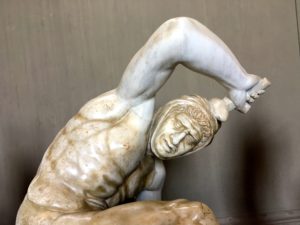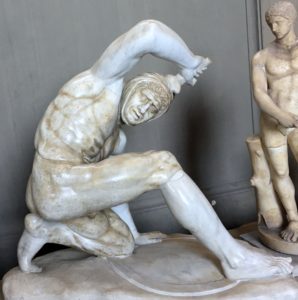The Persian Warrior / Vatican Museum
The Persian Warrior statue made of marble around 110 – 120 A.D. This is a copy from one of a group of four bronzes which commemorated Greek victories over Persians. (or all their enemies !)
The warrior is wearing a Phrygian beret, is shown in the moment of attempting an extremely defensive movement away from the enemy.
His body moving backwards and raising his right arm which wields his sword. The horror of his defeat is made more dramatic by the expression on the face.
These scupltures had been set up as a votive offering by Attalos II. of Pergamum around 160-150 B.C., on the Acropolis in Pergamum and in Athens. In Pergamon it’s called “Little Barbarians”.
The original or this statue belonged to a group which celebrated the triumph of the Greeks over the Persians following the famous Battle of Marathon in 490B.C.
This marble statue was discovered in Rome between 1503 – 1512, together with other copies of statues from Pergamum. Unearthed during the construction of the Medici Palace which is today Palazzo Madama.
Info about Persian warriors :
The Persian army in the Achaemenid period was massive and this was what allowed them to rule over a large portion of the Greater Iran region. The army itself was reported to be up to 150,000 warriors strong, which of course included the legendary Immortals.
The ancient Persian warriors were soldiers for the Persian Empire during the phases of its military life. The Immortals were the most renowned ancient Persian warriors, feared for their mass scale of the attack and the fact that if you were to kill one Persian warrior another one would appear instantaneously giving the appearance of course, that they were indeed immortal. It was during two phases of the Persian Empire, that the immortals were called upon to strike fear into their foes.





